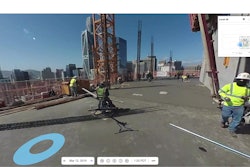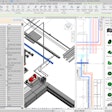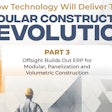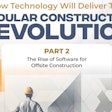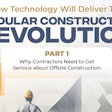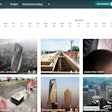
- DOWNLOAD THE PDF *Save to your desktop for easy reading & reference
Modern methods of construction, offsite construction, manufacturing blended construction—regardless of what you call it, these are the technologies to help you execute against these growing project delivery systems.
Why is Construction Moving Off Site?
- Better utilization of employees
- Quality-controlled environment
- Reduction in weather-related delays
- Lower embodied carbon
- Reduces material and tool theft from job sites
What Technology do Building Teams Need to Take Advantage OF?
- Shop-based materials requirements planning (MRP)
- Configuration-based software so projects can be comprised of increasingly standardized components
- Traceability tools to satisfy inspection requirements on site for closed panels
- Logistics software to manage work on site
- BIM and preconstruction technology capable of supporting Design for Manufacturing and Assembly (DFMA)
Mechanical electrical and plumbing contractors, precast concrete companies and manufactured home builders have long practiced various forms of offsite construction. But several trends are converging that will result in more value being placed upon shop-based environments.
Constrained labor availability means the labor efficiencies of assembly line or workstation-based environments will help building teams maximize labor productivity. Pressures by owners to lower cost and improve schedule and quality outcomes also favor the controlled shop environment. Shop-based fabrication also reduces the embodied carbon represented by the construction process, making it one way for building teams to satisfy project owners’ sustainability mandates.
According to a study by Dodge Data & Analytics, 50% of contractors find that using offsite construction methods like prefabrication and modular construction improves the cost of their projects compared to projects that do not use this approach. In addition, 42% find it improves schedule, 34% quality, and perhaps most crucially these days, 30% supply chain management.
“Panelized systems or multi-trade components focus on transferring on-site construction activities into a factory setting to help produce higher quality, more consistent products and reduce on-site labor,” International Code Council Vice President for Innovation Ryan Colker wrote on ForConstructionPros.com. “This is often a low-risk approach that also reduces on-site waste while offering decarbonization benefits. With nearly 30 percent of all building materials delivered to a construction site ending up as waste and the possibility of off-site constructed projects providing embodied carbon savings of up to 45 percent, this can create substantial sustainability benefits to communities worldwide.”
Proven Method Growing in Importance
Between 1969 and 1974, Housing and Urban Development Secretary George Ronmey oversaw Operation Breakthrough, a demonstration of the value of industrialized, factory-built construction methods in an attempt to catch up with successful programs in the Soviet Union. Operation Breakthrough saw the development of 22 housing systems including volumetric modular and panelized production. About 40 manufacturers participated, erecting 3,000 units at nine sites across the United States.
McKinsey has predicted that the size of the modular construction market could reach $130 billion in the United States by 2030. According to data from the National Insulation Association (NIA), offsite had crested $85 billion in 2020 globally.
These facts are some of the drivers behind contractors making the investments necessary to create more value in a shop-based environment rather than on site. According to a 2023 data set from Autodesk, 54% of AEC companies plan to invest more in sustainability in the coming years. This pressure is coming largely from customers (82%) versus government or regulators (78%). Despite an increasing focus on environment, sustainability and governance (ESG) investing, customers also eclipsed investors (76%) as a source of pressure for increased sustainability in construction. The Autodesk study also found 94% of respondents expect their industry or organization to make sustainability focused changes in the coming years and more than half indicate they will make these investments over the next three years.
The Autodesk study further found that 73% of companies in the AEC sector plan to invest in technology to deliver improved project outcomes and 70% plan to invest in product and/or service innovation.
All of these pressures to improve project outcomes and reduce environmental impact favor more offsite, modular or panelized construction.
The Role for Technology
Just as project delivery systems like design-build or engineer-procure-construct place certain demands on the construction software and technology a building team relies on, so does modular construction.
Technology for offsite construction is evolving to meet this demand. Existing construction software applications are evolving new functionality or forging partnerships with enterprise resources planning (ERP) and other software used by panel shop partners and others.
What unique problems do offsite, modular or panelized construction bring, and how do existing and emerging construction software products help?
Large-scale adoption of digital technologies in construction is a recent development, driven by the rise of mobile devices, cloud computing and investments in products to standardize back office functions and contain field production in a software workflow for visibility, control and efficiency.
As the industry absorbs this technological change, construction technology must also extend these digital construction workflows across shop-based production as off-site, modular, panelized and other modern methods of construction become key advantages for building teams driven to lower cost, compress timelines and reduce embodied carbon.
Construction ERP Has Some Answers
Broad project-based solutions and construction enterprise resource planning (ERP) software may address engineer-to-order manufacturing and construction has some capabilities that may be beneficial for modular. Epicor’s Kinetic product has been leveraged for offsite construction, as has Microsoft Dynamics 365 Business Central and ERP from IFS. A new ERP product launched in 2022 by Blackware Technology is designed to straddle both the construction and construction materials/component manufacturing sectors including offsite or modular construction settings.
According to Autodesk Head of Construction Strategy and Industry Partnerships Sidharth Haksar, the company behind Autodesk Build, Autodesk Construction Cloud and Revit is laying the groundwork for products that directly address offsite construction. The goal will be to help asset design come together in a process more similar to configure-to-order models in manufacturing, where a unique asset is created by configuring pre-existing parts or components. In many cases, prefabrication happens at the subcontractor or trade contractor level, and Autodesk wants to provide a common platform to specify fabricated components.
“We’ve got an incubation happening at Autodesk where what we’re trying to do is — think of the highest, simplest, way of product realization,” Haksar said. “So what we want to do is start to create a product library of components and products, so that if you’re a designer, you’re not creating and throwing an object into a model, that then the subcontractor especially looks at and says this is not designed for fabrication.
“They then have to redo the whole thing. At the end of the day, you know, there’s a finite set of products that you can end up using all the time. So, can we not provide a library upfront to the designers, so that they can end up specifying it? Then when the electrical contractor or the mechanical contractor gets it, that object is shop-ready."
Emerging Software for Offsite Construction
IRONPROS follows software for modular or offsite construction, and while ERP has been pressed into service in some of these settings, there are still gaps that must be closed to accommodate some unique processes, regulatory and logistics hurdles. But software designed specifically for portions of, or all of the offsite construction value chain are coming to market.
These products not only promise to encompass the elements missing from construction software— specifically manufacturing resource planning (MRP) for parts and materials, but labor management, shop-based scheduling in a workstation environment and quality control.
Other products focus on extending design and architectural software to coalesce better with the needs of component fabricators. An example of this may be the architect who is designing a building to be erected using precast concrete members. That designer will need to take into consideration the dimensions and characteristics of these standard parts.
QC and Inspection of Panels
One challenge of panelized construction is compliance with building codes where electrical or plumbing work must be inspected at a given point in the project. When a project relies on closed panels, the mechanical or plumbing elements to be inspected are already sealed up when they get to the construction site. We spoke to International Code Council Vice President for Innovation Ryan Colker about ICC’s partnership with Offsight Software which addresses this challenge.
“One of the benefits our partnership with Offsight offers to off-site construction is efficiency and process replicability and being able to track the project and its components,” Colker said. “Throughout the entire construction process Offsight really provides the basis for that type of tracking, following components throughout the factory and assuring that the quality assurance process is being applied.
"Offsite is offering to leverage some of the expertise from ICC NTA which is a third-party plan review and inspection agency. It works with many offsite construction manufacturers being able to integrate some of those software tools into the process and really build in that efficiency.” Colker said that panel and component manufacturers were the most natural entry point for technology to address these compliance challenges.
“The sweet point is the manufacturer themselves,” Colker said. “They’re the ones every day looking at quality assurance and those sorts of things. But I think there’s certainly utility for contractors that are working with a factory to be able to have that assurance that comes from being able to monitor where the project is, whether you have the report outputs being able to plan effectively for when different components arrive to the job site.”
Learn More with this Video Interview with Colker >>
Design for Manufacturing and Assembly (DFMA)
Taking the limitations and characteristics of individual offsite fabrication or manufacturing processes into consideration in design is one challenge Slate Technologies is addressing. The company’s current product line includes functionality that came through the May, 2022 acquisition of Splash Modular. At that time, IRONPROS debriefed former Splash Modular CEO and current Slate Technologies Vice President and Head of Industrialized Construction Joel Hutchines.
“Splash is focused on getting data in the hands of a designer to help them productize their processes,” Hutchines said. “Slate is really more focused on project managers and the general contractor. We are looking more at the data getting into the hands of the designer and using this scripting as a service model we have developed to build out a tool modular and offsite suppliers can use to productize their process and build value to generals.”
We later caught up with Hutchines on the challenges faced by building teams embarking on projects that require a thoughtful approach to DFMA.
“It’s probably worth touching on some of the limitations industrialized constructions face,” Hutchines said. “It’s based around manufacturing methodologies and manufacturing machinery which time and effort and skill sets to actually design for manufacturing and then taking the design intent and reconfiguring it. Every machine essentially takes its own input, its own code, to run. Now the process that we rarely talk about is that we have to take design intent from architectural detailing.
“We have to detail that into more complex CAD CAM to produce the code to run the machines. Now there’s a myriad of tools out there, but each one of those requires the design intent to change. There is, again often a process of re-manufacting or redesigning for the manufacturing. We address the quantified benefits of improving that to save us money. It can save us time. It can be better quality, but we rarely talk about the fact that we actually lose a lot of those efficiencies because of that process that I just described. We can actually have far more detailed insight into what the benefits of DFMA are-- if it does require extra changes in the design because you’re going to be better off. It is a big part of making sure you are delivering better.”
Learn More with these Video Interviews with Hutchines >>
Part 1
Part 2
Workface Planning
While a panel or component manufacturer or MEP contractor engaged in building out subassemblies in a shop environment may benefit from shop-based solutions, Manufacton Founder and CEO Raghi Iyenghar says ultimately, on-site and offsite teams must share a single version of the truth.
“The traditional software stack that’s been useful in construction continues to be the relevant kind at the backend,” Iyenghar said. “But what is really needed where we see things as a whole is at the workface so the people in the factory, in procurement and at the job site, all of them at the workface need to have the equivalent of a production control system in order to be able to manage what it is that they are producing, delivering and installing at that product level.”
“What is missing in terms of the tech stacks is they are traditionally more project-oriented more task-oriented rather than actually taking products through a whole lifecycle. Software needs to extend from planning and design and procurement for the materials that are needed in inventory to produce it. Software needs to address the Q&A side of it. Software needs to support getting it staged and delivered and complete the installation and do a QC. Yeah, but it needs to address that whole lifecycle for that product which could be anything that goes into that building.
Learn More with this Video Interview with Iyenghar >>
In this deep interview with Offsight Founder and COO Andrew Xue we look at where this specialized software product is now and where it is headed as it seeks to become a standard for plants supplying contractors using modern methods.
Founded in 2020, Offsight bridges the gap between manufacturing resources planning (MRP) for shop-base fabrication and project management software to support manufacturing-blended construction.
The company has raised $6.4 million in two seed rounds. With an employee base in the low double digits, a solid game to cost-effectively land new customers, a partnership with the International Code Council and a well-developed network of other collaborators, they may be more sustainable than many other venture-funded construction-related software companies.
Offsight diverges from many other software offerings for modern methods of construction because it deals less with elements like design for manufacturing and assembly (DFMA) and more with the fabrication and delivery of modules on site. The company works as part of the construction technology ecosystem with integrations with significant players including Revit and Procore.
IRONPROS caught up with Offsight COO Andrew Xue in an April 2023 discovery call.
IRONPROS: So Andrew, you are a growing company, and that is driven by the team of people you have with boots on the ground selling. What does that team look like?
Andrew Xue: I’m just probably one of that team, and the founder is another and then a sales director. We also have a partner program for consultants that work with module factories that help them set up the new factory and help them build their quality manual.
IRONPROS: When I think of that financial decision maker, who may be concerned with fighting SaaS sprawl and doing the due diligence on products, you know, particularly those that are venture funded, they may be happy to see these success factors that will make you more stable than some other entities.
You’re not completely reliant on your internal base of employees to build the business. But once you have secured that new customer, what kind of team do they get for customer success initially during onboarding and then on an ongoing basis?
Andrew Xue: It depends on what stage they are, right? Where is the factory and production process at and what are their needs? This is one big benefit of being vertically and industry focused, because we just have a lot of knowledge in terms of what they need to do. So that vertical analysis allows us to help them much more than a generic software.
New clients get a cloud application manager. But quality of that person is important. One person that we have, used to run quality management at a module factory for like eight years. So, he knows the inner workings of what needs to get done, how things are set up and how to build a quality manual that gets approved by third party inspectors or by the state. All that knowledge, if you don’t have it, you have to hire for it and that can take months, and set you back some money, or maybe you can plan to hire consultants to help you do it. So, we have the knowledge to share with you, we do have some cases where we help our customers interview quality managers and other roles, which is beyond the scope of what most companies do. But since we like to partner with clients, their success is our success.
IRONPROS: Is there a designated contact that each customer gets or does that come on a tiered basis where if you’ve got X number of users or X number of dollars, you wind up getting a designated person who stays with your account.
Andrew Xue: Every customer gets a designated person. So, the growth in the industry is so fast, it makes sense to be very close to all our clients so we can help them. But it depends on the factory. So like, let’s say a manufacturer is one of the biggest clients. In that case, they have multiple dedicated people from Offsight working on their account. It’s not just one person, because they have perhaps six accounts with us, and that one person can’t handle six accounts.
IRONPROS: Again, if I am that cautious enterprise software buyer, they can look at that and realize we’ve got someone here to help us, and they are actually pretty smart, too. But where is Offsight headed? What important initiatives is the company working towards right now?
Andrew Xue: I think we are consistently building up more functionality, and constantly asking what are some core features that clients are looking for? And then, if we can build these features, what would it mean for their success? Because there’s a lot of software out there that isn’t built specifically for this sector or to work with other systems.
So, our main goal is just to offer performant products, like our production tracking, for instance. There, we are tracking all the modules, the panels, the parts, wherever they move and their progress. Our customers can then generate reports required by state regulation or third parties. We have streamlined that process, along with materials management which we added about six months ago.
We’re building up that feature set to kind of do the whole end to end from an MRP perspective. We have labor tracking, which is relatively new to essentially help you track employees’ labor, including labor time, time in and time out. And then we can consolidate that with payroll, so you have like the whole suite of analytics around the factory. We are building in more holistic views now that we have this functionality and the data. Having that put together and having a 1,000 foot view of how healthy the factory is and having those dashboards set up—those are our priorities I guess.
IRONPROS: So when you talk about materials management, are you dealing with this primarily as, like, a warehouse management system (WMS) with bin management and, inventory levels or are you also squaring that with demand from orders in hand and projected orders—how deep are you going into that MRP space?
Andrew Xue: We go fairly deep in some ways. I think the goal over the next probably year or so, is to be a full-on enterprise resource planning (ERP). That’s actually the long-term goal primarily because ERP is right now on really, under the old world older, not very user friendly. The UI is in gray, and the views are more for accountants than they are for plant operations. And that’s just like the reality of solutions out there. So this, in my mind will be the new age ERP, where it has the best of both worlds, and where we could manage operations data really well, as well, as the financial data for the accountants and stuff like that.
IRONPROS: And then for labor tracking, are you finding that a lot of your customers do, in fact, have a union labor force where you have to deal with the union labor and work rules and wage rates and everything like that?
Andrew Xue: Currently, we don’t process payroll, we just do the labor hour tracking. So essentially, the goal would be in this case, to figure out how productive everyone is.
So let’s give an example. Let’s say someone clocks in for eight hours. These are soft—you can see within the eight hours, what did they actually work on, which stations were they were in, which panel they worked with within a building at some point in time. And then ultimately, when you are planning for a project, you can say, “Okay, this project is budgeted for 10,000 labor hours,” and then at a point in production, you can say, “I spent 5,000 hours on these roles already.” And you can pull that from our software. If I spent half the labor hours, how far am I in production?
If I’m only 30% done on the modules, but I spent 50% of my labor, that’s not a good scenario, right? You can look at labor tracking as a way to optimize the workforce for your recruitment operations.
IRONPROS: And then are you getting into more of the supply chain side of it? Or are you really kind of picking up once the materials are in the door?
Andrew Xue: We are part of the supply chain solution and do want to track material data. So once material is just below safety stock, or minimum stock levels, we can create a purchase order, and the purchase order can potentially be shared with suppliers. Then suppliers will send invoices, and we track that whole process of P.O., invoice, paid, and shipment of product.
IRONPROS: And across that process, are you delivering serial, lot or batch tracking for things where you may need to have that kind of traceability?
Andrew Xue: Definitely. We can get very complex based on the supply chain, or I can get multiple suppliers that are supplying the same product at different prices. And, you know, that’s where things get a little bit complicated from that perspective. So a software needs to essentially compensate for those.
IRONPROS: So if a contractor is creating a series of panels for a project, and we’re noticing failures of some of the components we’re putting in there, can you then trace that back through the supply chain to figure out where they came from, and stuff like that?
Andrew Xue: Yeah. So, one of the big things, you can centrally set like a bill of materials (BOM) for a project. So, the BOM that you created has the pick list—it is the set materials that need to be used during a project. If materials that aren’t good or things are not installed correctly, you wind up with waste— essentially, scrap that is thrown out. You want to track that and you want to track when it happens.
So, we do track waste per product per station. Yeah, it was this joining station and then we know where that material came from because there’s a part and a link to it in the application. You want to track the waste rate, which is a percentage per material that you buy. So, if you have 100 screws, or boxes, or panels or whatever product you’re buying, if you scrap 10% that is very high. You want to probably be below 2% to 3% for both of your materials.
And then if you do find a high scrap rate, let’s say it’s 5% but it’s caused by supply quality, you can negotiate better rates, because you have the data. “Hey, you know, the last batch we bought us cost us this percent. Here’s some photos, can you give me a discount?” The software then directly saves the money.
IRONPROS: Is that traceability something that survives the transition to the finished asset, to be used in the course of that lifecycle? Maybe the owner starts to have structural elements failing in a panel, can they then figure out retroactively what’s going on with this?
Andrew Xue: So let’s say, in this one station, the failure rates are very high. And then the scrap rates are high. You then know to address that with your supplier or suppliers, or else you’re going to continue to have these quality issues.
It could be anything, even the design that’s causing it. So, you can kind of pinpoint it before it leaves the factory. The big thing is, once it leaves, the factory delays can get exponentially worse. Or if you find it early, you can kind of catch it. And it won’t delay the project time that much.
IRONPROS: Are you using this application primarily for panels and things that already have components and assemblies and sub-assemblies that might have some degree of mechanical sophistication, a warranty or something that applies?
Andrew Xue: We can do pretty much any type of building component. So, we started out doing volumetric modules, which is the more complicated side of things, but now we can do different panels, bath pods, kitchen pods, prefabricated MEP modules. We actually just got a client in cabinets, so they’re doing joinery and woodworking type things. So, we can deliver any type of building component that has some project-based design related to it, like project-based manufacturing.
IRONPROS: But then if you have in this MEP pre-assembly, we have pumps or compressors or things like that which might have a warranty or other important information, are you able to provide data to support the quality traceability and maybe serial traceability of that over the assets lifecycle, or ability to help the owner do that?
Is the information from within Insight about the panels, components, subassemblies available after the project by living on as part of building information management (BIM)?
Andrew Xue: Potentially. So essentially, what we have is time series data around building a product, right? How the data gets fed back in for when we do the next project, we should make some modifications or whatever to include the design - that more or less could be done.
IRONPROS: So, let’s talk a little bit about the tech stack. And we can take a lifetime on some of this. But, where does the product live in the cloud? What is it made out of from the presentation layer, mid-tier and the back end?
Andrew Xue: We essentially are a multi-tenant software as a service (SaaS) application on Amazon Web Services (AWS). So, everything’s in the cloud, nothing’s on prem. So that kind of drives the whole business. The back end is MySQL. We will have apps for iPad and iPhone, and some of our clients are using Android tablets. We’re developing those in Angular now but plan to move to React later to improve build speeds.
IRONPROS: And then how often are you shipping product?
Andrew Xue: Every two weeks
IRONPROS: So, while you aspire to be more of a complete ERP for volumetric and offsite construction, do you plan to get into delivering the general ledger or even accounts payable and accounts receivable?
Andrew Xue: So, that the accounting side, and our clients may use a NetSuite for the accounting portion of it. But then they’ll use us, instead of buying the manufacturing module for NetSuite, because we will pretty much be built for this type of factory, which is project-base manufacturing.
For a lot of traditional ERPs, they’re actually very good at batch manufacturing. In a past life, I would help set up these factories to do that. I used to work with a lot of ERPs back in a day. And you know, when I started Offsight, I just thought, there has to be a better way to do entry on the factory floor. And all ERPs I’ve ever worked with were painful, like extremely painful getting any data on the floor.
IRONPROS: Yeah, there are a lot of them, and some, as soon as the project is in process, are in another dimension. And then you’d have something like a manufacturing execution system that would maybe pick up from there. Which is another million dollars. And then you have to integrate that MES with ERP
Andrew Xue: So that is why we have an MES built into our production tracking module that’s already included.
IRONPROS: So hey—you got me. I’m sold, but as you are selling to companies in the field, who else are you seeing in these deals? Who are you bumping heads with?
Andrew Xue: It depends. Some people may think about ERP first, and then they’ll look at project management and operations. From that perspective, we’ve seen the big ERPs. And in those situations, if we lose, we come back maybe three, six, nine months later, in some cases they never actually get it deployed, which is unfortunate.
Most of the competition is still paper, in a weird way. Sometimes we have a client that has gotten their plant operational and then later looked for a digital solution, which is probably not the best strategy given that you’re creating habits on the floor.
If you have a new factory, and you want to have this built in from the beginning, right? So certain aspects of it is more of a cultural thing about technology than it is about getting the software itself. So, it ends up being a move to replace the Excel.
I think we’ve come into deals and seen Manufacton, if you’ve heard of those guys, at some point. And Slate Technologies. Those two and some other tools that you might run into are essentially design tools.
IRONPROS: A lot of ERPs will be fine for project-based manufacturing in general. How do you hand that off to generals? And what tools do you allow to make sure that dovetails well with what you’re manufacturing?
Andrew Xue: So that’s kind of the challenge in the industry, right? Like, how can you build a process that is streamlined for whatever you’re building in a software that kind of matches their use cases. But it sucks. A lot of these companies in the early days, maybe pivoted, and instead of doing commercial maybe they also wanted to do multifamily, and then wound up having a panelized business on the side, while you do live volumetric modules.
A lot of these companies accommodate everything, and that’s the kind of thing that ERPs never do well. And that’s kind of what we want to do very well—essentially deliver the flexibility in the project-based production side of things where you’re not overpaying for a set process.
IRONPROS: So, what are the pain points motivating prospects to sign up right now with Offsight?
Andrew Xue: Yeah, it’s demand, right? They’re getting so much demand that they realize they can’t manage it with their existing process. That’s kind of the big factor that we’re seeing here. And that happens with growing markets. And that’s kind of why startups like mine exist. Because if the market isn’t growing, there’s absolutely no reason to change right?
As they invest in growth, they’re going to want a level of quality, of stability, because they’re putting up all this money and they want to know that you have processes in place. With the growth factor that we’re seeing, it is to triple or quadruple over the next five years. And then startups like us, who are essentially well positioned in the market, can take advantage.
IRONPROS: Now let’s talk a little bit about the pricing strategy. So, if I come to you and say: I need this. How much is this going to cost me? How do you figure that out?
Andrew Xue: We actually do it by the square footage of the factory. And then we have modules that you buy, right? We start with the core module, which is production quality, importing that into the core of the business to get you started. Then you can add material management, or you can add labor management, materials issuance management etc. It is not that different than Procore in its business model.
_____
**Click here to download and save How Technology Will Deliver the Modular Construction Revolution

